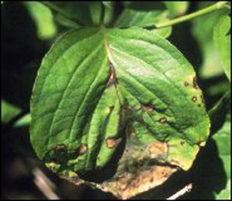Dogwood anthracnose is a common tree disease of flowering and Pacific dogwood. The origin of the disease is unknown, but it is believed to have been introduced to the United States in the mid 1970’s. An anthracnose fungus, Discula destructiva, has been identified as the causal agent. Anthracnose infections of Pacific dogwood have been discovered across Washington, Oregon, and Idaho. Infections of flowering dogwood have been reported across much of the Northeast region, including Massachusetts, New Hampshire, Maine, Connecticut, New York, New Jersey, Pennsylvania, and Delaware. The disease has also been detected in a number of other states, including Maryland, Virginia, West Virginia, North and South Carolina, Tennessee, and Georgia. Prolonged infection from anthracnose can decimate dogwoods. Consecutive years of heavy infection often results in extensive mortality in both Pacific and flowering dogwood.
Symptoms of Dogwood Anthracnose
Infection of dogwoods is favored by cool, wet conditions in spring. Drought stress and winter injury can exacerbate the disease. Initial foliar symptoms develop in the lower crown in May and June. Brown spots or lesions up to ¼ inch in diameter form on both the upper and lower leaf surfaces. These lesions may be circular or irregular in shape, with distinctive purple-brown margins. As the infection progresses, leaf lesions tend to become more numerous, eventually coalescing. This leads to the development of large, necrotic areas on the infected leaf. Black fruiting structures may sometimes form within the centers of foliar lesions. If an entire leaf becomes infected, the fungus will proceed into the petiole, followed by the twig. This causes cankers to form on the infected leaf. The cankers that form are often tan, with a slightly sunken appearance.
Flower bracts are also susceptible to infection. When infected, they develop reddish-brown spots or blotches. These are most prevalent when rainy conditions prevail during flowering. Anthracnose fungi can directly infect shoots during spring and fall. These infections develop into small cankers, which gradually increase in size. As the cankers become larger, they create a girdling effect on healthy tissue. This often results in significant foliar dieback. When severely defoliated, some trees will attempt to compensate for the loss of growth by producing succulent shoots on the lower trunk and main branches. These branches, also called epicormic sprouts, are highly susceptible to infection. Sprout infections tend to spread quickly to the trunk, causing large cankers and splits to form in the bark.
Effective Management Practices
The effects of dogwood anthracnose can be minimized by employing the following practices:
- When planting, consider plant resistant species or cultivars. Kousa dogwood is less susceptible to infection than flowering dogwood.
- Prune and dispose of dead wood or cankered limbs. Dead wood and cankered limbs are susceptible to infection from anthracnose fungi. Removing them helps reduce the ability of the fungus to grow into the main trunk.
- Rake and remove fallen leaves to remove potential sources of overwintering fungi.
- Maintain tree vigor by following sound cultural practices.
- Applying a balanced fertilizer in early spring can bolster tree vigor.
- Follow proper pruning practices to improve air circulation throughout the tree.
- Ensure that trees are sufficiently watered, especially during dry periods.
- Applying a layer of organic mulch around a tree can help maintain soil moisture, moderate soil temperatures, improve soil quality, and minimize the potential for mechanical injuries.
- Treat insect infestations through biological or chemical control practices.
- Fungicides can assist in disease management. The initial application should be made just prior to budbreak, before new leaves and shoots expand. Two or three additional applications can be made during leaf expansion, at ten to fourteen day intervals. Further applications may be necessary during wet or prolonged spring conditions.
- Some of the more effective compounds available for use include chlorothalonil, copper hydroxide, mancozeb, and thiophanatemethyl. Organic alternatives include copper products, sulfur, Serenade, and potassium bicarbonate. When using any of these, consult the label for dosage rates and safety precautions.


